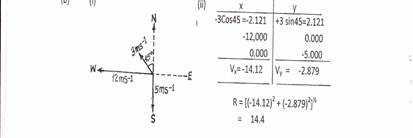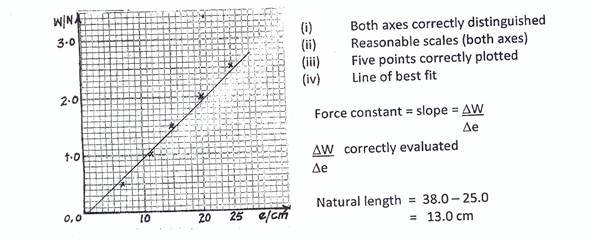Part (a) the definition of a vector quantity posed no problem to most candidates. Performance was high.
Part (b), candidates failed to put down a correct sketch of the vector diagram as a result of not indicating directions or using reasonable relative lengths to represent magnitudes. The resultant vector sort could not be determined due to inability to put down a correct sketch. The direction of the resultant vector was not determined by few candidates that were able to determine the resultant vector magnitude correctly.
Part (c), many candidates could not plot the graph correctly. Scales were wrongly chosen, points were wrongly plotted and line of best fit could not be drawn. The natural length of the spring sorted for could not be determined. Generally, performance was fair.
The expected answers are
- A vector quantity is (a physical) quantity that has both magnitude and direction
- (i)

Sketch of vector diagram correctly showing and labeling relative length of arrows angles 45o and 90o
Tan θ = 2.879 = 0.2039
14.121
θ = 11.50
R = 14.4ms-1 S78.5oW
Mass m/g |
Weight W/N |
Extension e/cm |
50
100
150
200
250 |
0.5
1.0
1.5
2.0
2.5 |
6.5
11.0
15.0
20.0
25.0 |
-

Both axes correctly distinguished
- Reasonable scales (both axes)
- Five points correctly plotted
- Line of best fit
Force constant = slope = DW
De
DW correctly evaluated
De
Natural length = 38.0 – 25.0
= 13.0 cm
|



